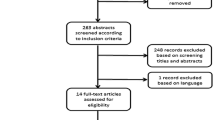Abstract
Background
Most osteoporotic vertebral fractures (OVFs) occur in the thoracolumbar area without neurological symptoms. The pathogenesis and clinical results of symptomatic lower lumbar OVFs have not been analysed. We aimed to retrospectively investigate the risk factors for the occurrence of neurological symptoms in patients with lower lumbar OVFs and to assess the clinical results of these symptoms using magnetic resonance (MR) images.
Methods
Of the 104 patients enrolled, 21% reported neurological symptoms. We divided OVFs with neurological symptoms into various types using early MR images and investigated the risk factors for each type. Clinical results of symptomatic patients were also evaluated.
Results
Symptomatic patients with lower lumbar OVFs mainly had one of two fracture types, indicated by total low and superior/inferior low-intensity signals on T1-weighted images. A multivariate logistic regression analysis showed that a smaller canal area and longer disease duration were risk factors for all patients. For patients with OVFs indicated by total low intensity, symptomatic patients had a significantly smaller canal area than non-symptomatic patients. For patients with OVFs indicated by superior/inferior low intensity, symptomatic patients had a significantly higher frequency of L4 and L5 vertebral fractures, longer disease duration, smaller canal area, smaller angle between the facets, and higher frequency of coexisting degenerative spondylolisthesis than non-symptomatic patients. Symptomatic patients with OVFs indicated by total low intensity had poorer clinical results regarding walking ability than symptomatic patients with OVFs indicated by superior/inferior low intensity.
Conclusions
Lower lumbar OVFs with neurological symptoms might have two different pathogeneses according to early MR images. Compared with symptomatic patients with OVFs indicated by superior/inferior low intensity, symptomatic patients with OVFs indicated by total low intensity may require different treatment strategies to avoid symptoms.






Similar content being viewed by others
References
Baba H, Maezawa Y, Kamitani K, Furusawa N, Imura S, Tomita K (1995) Osteoporotic vertebral collapse with late neurological complications. Paraplegia 33:281–289
Chung SK, Lee SH, Kim DY, Lee HY (2002) Treatment of lower lumbar radiculopathy caused by osteoporotic compression fracture: the role of vertebroplasty. J Spinal Disord Tech 15:461–468
Fukui M, Chiba K, Kawakami M, Kikuchi S, Konno S, Miyamoto M, Seichi A, Shimamura T, Shirado O, Taguchi T, Takahashi K, Takeshita K, Tani T, Toyama Y, Yonenobu K, Wada E, Tanaka T, Hirota Y, Subcommittee of the Clinical Outcome Committee of the Japan Orthopaedic Association on Low Back Pain and Cervical Myelopathy Evaluation (2009) JOA Back Pain Evaluation Questionnaire (JOABPEQ)/JOA Cervical Myelopathy Evaluation Questionnaire (JOACMEQ). The report on the development of revised versions. April 16, 2007. The Subcommittee of the Clinical Outcome Committee of the Japanese Orthopaedic Association on Low Back Pain and Cervical Myelopathy Evaluation. J Orthop Sci 14:348–365
Genant HK, Wu CY, van Kuijk C, Nevitt MC (1993) Vertebral fracture assessment using a semiquantitative technique. J Bone Miner Res 8:1137–1148
Kanchiku T, Imajo Y, Suzuki H, Yoshida Y, Taguchi T (2014) Usefulness of an early MRI-based classification system for predicting vertebral collapse and pseudoarthrosis after osteoporotic vertebral fractures. J Spinal Disord Tech 27:E61–E65
Kanchiku T, Taguchi T, Kawai S (2003) Magnetic resonance imaging diagnosis and new classification of the osteoporotic vertebral fracture. J Orthop Sci 8:463–466
Kaneda K, Asano S, Hashimoto T, Satoh S, Fujiya M (1992) The treatment of osteoporotic-posttraumatic vertebral collapse using the Kaneda device and a bioactive ceramic vertebral prosthesis. Spine (Phila Pa 1976) 17:S295–S303
Kempsky WH, Morgan PP, Boniface WR (1958) Osteoporotic kyphosis with paraplegia. Neurology 8:181–186
Lee YL, Yip KM (1996) The osteoporotic spine. Clin Orthop Relat Res 323:91–97
Mochida J, Toh E, Chiba M, Nishimura K (2001) Treatment of osteoporotic late collapse of a vertebral body of thoracic and lumbar spine. J Spinal Disord 14:393–398
Nakajima H, Uchida K, Honjoh K, Sakamoto T, Kitade M, Baba H (2016) Surgical treatment of low lumbar osteoporotic vertebral collapse: a single-institution experience. J Neurosurg Spine 24:39–47
Sasaki M, Aoki M, Nishioka K, Yoshimine T (2011) Radiculopathy caused by osteoporotic vertebral fractures in the lumbar spine. Neurol Med Chir (Tokyo) 51:484–489
Shen M, Kim Y (2007) Osteoporotic vertebral compression fractures: a review of current surgical management techniques. Am J Orthop (Belle Mead NJ) 36:241–248
Taneichi H, Kaneda K, Oguma T, Kokaji M (2002) Risk factor analysis for osteoporotic vertebral collapse and pseudoarthrosis. Rinshyouseikeigeka (Jpn) 37:437–442
Tsujio T, Nakamura H, Terai H, Hoshino M, Namikawa T, Matsumura A, Kato M, Suzuki A, Takayama K, Fukushima W, Kondo K, Hirota Y, Takaoka K (2011) Characteristic radiographic or magnetic resonance images of fresh osteoporotic vertebral fractures predicting potential risk for nonunion: a prospective multicenter study. Spine (Phila Pa 1976) 36:1229–1235
Acknowledgements
We would like to thank Editage (www.editage.jp) for English language editing.
Funding
This work was supported in part by Japanese Orthopaedic Association Grants-in-Aid for Scientific Research (E.N.). The sponsor had no role in the design or conduct of this research.
Author information
Authors and Affiliations
Corresponding author
Ethics declarations
Conflict of interest
The authors declare that they have no competing interests.
Ethical approval
The ethics committee for human research at our hospital approved the study protocol, and informed consent to undergo an examination and operation was obtained from all patients. All procedures performed in studies involving human participants were in accordance with the ethical standards of the institutional and/or national research committee and with the 1964 Helsinki declaration and its later amendments or comparable ethical standards.
Informed consent
Informed consent was obtained from all individual participants included in the study.
Additional information
Publisher’s note
Springer Nature remains neutral with regard to jurisdictional claims in published maps and institutional affiliations.
This article is part of the Topical Collection on Spine trauma
Rights and permissions
About this article
Cite this article
Oishi, Y., Nakamura, E., Murase, M. et al. Lower lumbar osteoporotic vertebral fractures with neurological symptoms might have two different pathogeneses according to early magnetic resonance images. Acta Neurochir 161, 2211–2222 (2019). https://doi.org/10.1007/s00701-019-04045-6
Received:
Accepted:
Published:
Issue Date:
DOI: https://doi.org/10.1007/s00701-019-04045-6




